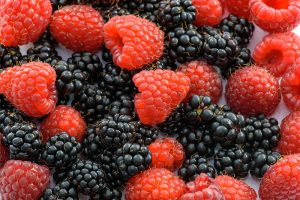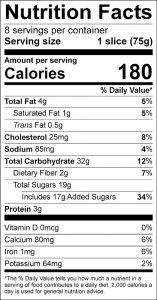Bulletin #4267, Vegetables and Fruits for Health: Raspberries and Blackberries
 Revised and updated by Extension Professor Louise O. Kirkland, University of Maine Cooperative Extension.
Revised and updated by Extension Professor Louise O. Kirkland, University of Maine Cooperative Extension.
Originally developed by Extension Nutrition Specialist Nellie Hedstrom, University of Maine Cooperative Extension.
For information about UMaine Extension programs and resources, visit extension.umaine.edu.
Find more of our publications and books at extension.umaine.edu/publications/.
Raspberries and blackberries are delicious in the summer months when they are picked in season. Many farms offer “pick-your-own” berry patches. If you pick enough, you can enjoy berries out of your freezer in other seasons.
Buy berries all summer long for fresh, tasty, and wholesome food. Locally cultivated raspberries and blackberries become available after strawberries. Wild raspberries and blackberries can be gathered in late summer. What a special treat!
Nutrition Information
Berries are low in calories when eaten raw. A half-cup of berries ranges in calories from 30 to 40, depending on the type. For fresh berries, use one cup as a serving size. But there’s no need to worry about limiting amounts of eat fresh, raw berries. You only need to limit added sugar or high-fat products like pie crust or whipped topping, which add calories and fat. Choose serving methods that will provide you with the most nutrients and the least fat and sugar. One-half cup of some berries provides 100 percent of the recommended vitamin C for an adult. Berries are also rich in potassium.
Selection
If you gather berries from a “pick-your-own” patch, go at the beginning of the season to get premium berries. During the later part of the season, berries will be smaller and less fully developed, but still juicy. You may want to use some of the smaller berries for jams if you “put up” jams, or for baking. Size is also determined by the variety of berry. Some people think that the small to medium berries have better flavor than larger berries.
Roadside stands and farmers markets will provide you a source of fresh raspberries from mid July through the first part of August. Blackberries will be available for a little longer.
For the best price and flavor, buy berries in the summer. Check the berries to make sure that they are plump and without mold. For the best raspberries, check that each individual small cell making up the berry is plump and tender, not mushy or immature. No attached stems will be on good-quality raspberries and blackberries. Wild berries may taste sweeter than cultivated fruits.
Storage
As soon as you get the berries home, check them over and discard berries that show any signs of decay, mold, or other spoilage. Use blackberries within a couple of days.
Raspberries are more fragile than other fruits. Because of their delicate composition, the keeping quality of these berries is limited. Raspberries should be eaten soon after harvest and not stored for more than a day. The fragile characteristics of the raspberry make it more expensive than other types of berries.
Preparation
Blackberries can be washed, drained, covered, and stored in the refrigerator for later use. Store unwashed raspberries covered in the refrigerator. Wash raspberries before using.
There are many uses for berries. Use them in baked goods, blender drinks, fresh with milk and sugar, in sauces, over desserts, or just eat them as is. Many people use them in main-dish soups, hot or cold. Of course, putting up jams and preserves is a way to make sure you enjoy berries in the winter months.
Summertime Fruit Salad
1/2 cup orange juice
1/4 cup honey
2 cups strawberries, stemmed and halved
2 cups raspberries
2 cups blueberries
1 cup cantaloupe, cut in bite-sized pieces
fresh mint leaves
In medium bowl, whisk juice and honey; add remaining ingredients. Toss gently to combine. Chill 1 hour. Spoon salad into 4 individual bowls, dividing equally.
Raspberry Coffeecake
1 cup raspberries, fresh or frozen
3 tablespoons brown sugar
1 cup flour
1/3 cup sugar
1/2 teaspoon baking powder
1/4 teaspoon baking soda
1/2 cup plain low-fat yogurt
2 tablespoons margarine, melted
1 teaspoon vanilla flavoring
1 egg
cooking spray
1 tablespoon sliced almonds
1/4 cup powdered sugar
1 teaspoon skim milk
1/2 teaspoon vanilla flavoring
Toss raspberries with brown sugar in a bowl until coated. Set aside. Combine flour and next 3 ingredients in a large bowl. Combine yogurt and next 3 ingredients in a separate bowl. Stir well. Add wet ingredients to dry ingredients, stirring just until moistened. Spoon two thirds of batter into an 8-inch round cake pan that has been coated with cooking spray. Top with raspberry mixture. Spoon remaining batter over raspberry mixture; top with almonds.
Bake at 350°F for 40 minutes or until a wooden pick inserted in center comes out clean. Let cool for 10 minutes. Combine powdered sugar, milk, and vanilla. Stir well. Drizzle over cake. Serve warm or at room temperature.
Some content adapted with permission from University of Massachusetts Cooperative Extension.
Information in this publication is provided purely for educational purposes. No responsibility is assumed for any problems associated with the use of products or services mentioned. No endorsement of products or companies is intended, nor is criticism of unnamed products or companies implied.
© 2008
Call 800.287.0274 (in Maine), or 207.581.3188, for information on publications and program offerings from University of Maine Cooperative Extension, or visit extension.umaine.edu.
The University of Maine is an EEO/AA employer, and does not discriminate on the grounds of race, color, religion, sex, sexual orientation, transgender status, gender expression, national origin, citizenship status, age, disability, genetic information or veteran’s status in employment, education, and all other programs and activities. The following person has been designated to handle inquiries regarding non-discrimination policies: Sarah E. Harebo, Director of Equal Opportunity, 101 North Stevens Hall, University of Maine, Orono, ME 04469-5754, 207.581.1226, TTY 711 (Maine Relay System).



